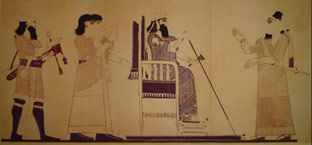Shalmaneser V (726–722 BC)

A wall painting from Hadatu (modern Arslan Tash) in Syria showing a seated Tiglath-pileser III receiving a report from the crown prince (Ulūlāyu). Reconstruction on display in the Louvre. Photo by Karen Radner.
When Tiglath-pileser III died in 727 BC, his son and designated successor, Shalmaneser (Akk. Salmānu-ašarēd, "The god Salmānu is pre-eminent"), ascended the thrones of Assyria and Babylonia; he is also called Ulūlāyu — "(One born in the month) Ulūlu" in royal correspondence and Babylonian Kinglist A. He should have been well suited to performing his duties as king since he had held an important role in his father's administration and since he had presumably been educated as the heir designate. Shalmaneser followed in his father's footsteps, namely by conquering and annexing several foreign lands and cities. His achievements included the conquest of the city Samaria, the capital of Israel (although the nature of its conquest has long been disputed among scholars), and possibly those of Samʾal and Que, kingdoms in north Syria and southeast Anatolia. Babylonia, which he inherited from his father, remained firmly in his hands.
Although the details of his reign remain obscure, Shalmaneser appears to have successfully maintained the kingdom, at least for a few years. However, during his fifth regnal year (722 BC), his tenure as king was brought to an abrupt and violent end. Sargon II, Shalmaneser's brother and immediate successor, records some of the details of the internal strife that took place in Assyria at that time, but describes those events in a manner that shows him, and not Shalmaneser, as the "legitimate king" of Assyria. The Babylonian Chronicle states that Shalmaneser died, but does not record the disruption that shook Assyria's foundations.
Browse online Shalmaneser V Corpus [/rinap/rinap1/corpus]
For further information on the inscriptions of Shalmaneser V, visit the RINAP 1 [/rinap/rinap1/index.html] portal page
Further reading
H.D. Baker, "Salmanassar V.," pp. 585-587 in M.P. Streck et al. (eds.), Reallexikon der Assyriologie und Vorderasiatischen Archäologie 11/7-8. Berlin, 2008.
A. Kirk Grayson, "Assyria: Tiglath-pileser III to Sargon II (744-705 B.C.)," pp. 85-86 in J. Boardman et al. (eds.), The Cambridge Ancient History, second edition, vol. 3/2. Cambridge, 1991.
K. Radner, "Salmanassar V. in den Nimrud Letters," Archiv für Orientforschung 50 (2003-04) pp. 95-104.
K. Radner, "Shalmaneser V, king of Assyria (726-722 BC)," [/saao/aebp/Essentials/Kings/ShalmaneserV/] Assyrian Empire Builders. London, 2010.
H. Tadmor and S. Yamada, The Royal Inscriptions of Tiglath-pileser III (744-727 BC) and Shalmaneser V (726-722 BC), Kings of Assyria (The Royal Inscriptions of the Neo-Assyrian Period 1). Winona Lake, 2011. [https://www.eisenbrauns.org/books/titles/978-1-57506-220-4.html] BUY THE BOOK. [https://www.eisenbrauns.org/books/titles/978-1-57506-220-4.html]
Jamie Novotny
Jamie Novotny, 'Shalmaneser V (726–722 BC)', The Royal Inscriptions of the Neo-Assyrian Period, The RINAP Project, 2025 [http://oracc.museum.upenn.edu/rinap/Neo-AssyrianHistoryOverview/ShalmaneserV726-722BC/]